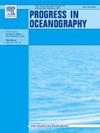Seasonal resource tracking and use of sea-ice foraging habitats by albatrosses and large petrels
IF 3.6
3区 地球科学
Q1 OCEANOGRAPHY
引用次数: 0
Abstract
The Antarctic seasonal sea-ice zone (SIZ) is one of the most extensive and dynamic habitats on Earth. In summer, increased insolation and ice melt cause primary production to peak, sustaining large populations of locally-breeding seabirds. Due to their hypermobility, large Procellariiformes, including albatrosses, breeding in the subantarctic also have the potential to access the SIZ and track macroscale resource waves over the Sothern Ocean but the extent to which they do this is poorly known. Here, we analysed the foraging movements of breeding albatrosses and large petrels (seven species, 1298 individuals) recorded using GPS loggers and satellite-transmitters to quantify their use of sea-ice habitats and test whether they tracked seasonal drivers of primary production. Foraging latitudes of white-chinned petrels Procellaria aequinoctialis and black-browed Thalassarche melanophris, grey-headed T. chrysostoma and wandering albatrosses Diomedea exulans varied sinusoidally over the breeding season, presumably in response to lagged effects of solar irradiance on primary production. Foraging latitudes of northern and southern giant petrels (Macronectes halli and M. giganteus), and light-mantled albatrosses Phoebetria palpebrata, exhibited no strong seasonal trend, but the latter two species spent ≥ 20 % of their time in the SIZ during incubation and post-brood, prior to or at the time of the spring ice breakup. Southern giant petrels travelled hundreds of km into the pack ice, encountering sea-ice concentrations up to 100 %, whereas light-mantled albatrosses remained almost exclusively in open water near the Marginal Ice Zone (MIZ). The remaining species spent up to 15 % of their time in the SIZ, typically from 5-7 weeks after breakup, and avoided the MIZ. This supports hypotheses that sea ice presents albatrosses but not giant petrels with physical barriers to flight or foraging, and that open-water-affiliated species use the SIZ only after primary production stimulated by ice melt transfers to intermediate trophic levels. Given that all seven species used the SIZ, it is likely that the phenology and demography of these and many other subantarctic-breeding seabirds are mechanistically linked to sea-ice dynamics. Declines in Antarctic sea ice predicted under climate change could therefore modulate and exacerbate the already unsustainable anthropogenic impacts being experienced by these populations.
信天翁和大海燕对海冰觅食栖息地的季节性资源追踪和利用
南极季节性海冰区(SIZ)是地球上最广阔、最具活力的栖息地之一。夏季,日照增加和冰层融化导致初级生产力达到顶峰,维持着大量在当地繁殖的海鸟种群。包括信天翁在内的在亚南极繁殖的大型海鸟具有超机动性,因此它们也有可能进入SIZ并追踪南大洋上空的宏观资源波,但对它们这样做的程度却知之甚少。在这里,我们分析了利用全球定位系统记录仪和卫星发射器记录的繁殖信天翁和大型海燕(7个物种,1298只个体)的觅食活动,以量化它们对海冰栖息地的利用,并检验它们是否跟踪初级生产的季节性驱动因素。白翅海燕、黑眉信天翁、灰头信天翁和游荡信天翁的觅食纬度在繁殖季节呈正弦曲线变化,这可能是太阳辐照度对初级生产的滞后影响。北方和南方巨海燕(和)以及光斑信天翁的觅食纬度没有表现出强烈的季节性趋势,但后两种鸟在孵化和产卵后、春季破冰前或破冰时,有≥20%的时间是在SIZ内度过的。南方巨海燕深入冰群数百公里,遇到的海冰浓度高达100%,而轻幔信天翁几乎只停留在边缘冰区附近的开阔水域。其余物种在海冰区停留的时间最多为 15%,通常在破冰后 5-7 周内停留,并避开海冰区。这支持了以下假设:海冰为信天翁提供了飞行或觅食的物理障碍,但没有为巨海燕提供物理障碍;只有在冰融化刺激的初级生产转移到中间营养级之后,隶属于开阔水域的物种才会使用SIZ。鉴于所有 7 个物种都使用 SIZ,这些物种和许多其他亚南极繁殖海鸟的物候学和人口学很可能与海冰动力学存在机理联系。因此,根据气候变化预测的南极海冰的减少可能会调节和加剧这些种群正在经历的已经不可持续的人为影响。
本文章由计算机程序翻译,如有差异,请以英文原文为准。
求助全文
约1分钟内获得全文
求助全文
来源期刊

Progress in Oceanography
地学-海洋学
CiteScore
7.20
自引率
4.90%
发文量
138
审稿时长
3 months
期刊介绍:
Progress in Oceanography publishes the longer, more comprehensive papers that most oceanographers feel are necessary, on occasion, to do justice to their work. Contributions are generally either a review of an aspect of oceanography or a treatise on an expanding oceanographic subject. The articles cover the entire spectrum of disciplines within the science of oceanography. Occasionally volumes are devoted to collections of papers and conference proceedings of exceptional interest. Essential reading for all oceanographers.
 求助内容:
求助内容: 应助结果提醒方式:
应助结果提醒方式:


